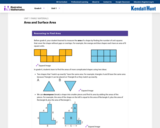
Family facing 6th Grade math unit focusing on area and surface area.
- Subject:
- Geometry
- Mathematics
- Material Type:
- Unit of Study
- Provider:
- Illustrative Mathematics
- Date Added:
- 11/17/2020

Family facing 6th Grade math unit focusing on area and surface area.
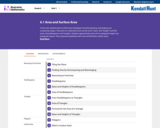
In this unit, students learn to find areas of polygons by decomposing, rearranging, and composing shapes. They learn to understand and use the terms “base” and “height,” and find areas of parallelograms and triangles. Students approximate areas of non-polygonal regions by polygonal regions. They represent polyhedra with nets and find their surface areas.
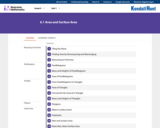
Student facing 6th Grade math unit focusing on area and surface area.

Defines and examines the law of sines through examples and a video lesson. [2:02]

Get information about trigonometric functions by viewing examples and a video lesson. [2:08]

This lesson presents the idea that the area of any triangle is exactly half of a certain parallelogram -- thus we get the familiar formula of multiplying the base and the altitude and taking half of that. The lesson contains varied exercises for students.

Learn the formula for the area of a triangle, one half base times height. [5:29]
Khan Academy learning modules include a Community space where users can ask questions and seek help from community members. Educators should consult with their Technology administrators to determine the use of Khan Academy learning modules in their classroom. Please review materials from external sites before sharing with students.
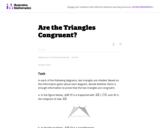
The purpose of this task is primarily assessment-oriented, asking students to demonstrate knowledge of how to determine the congruency of triangles.

Video tutorial introduces the area of a rectangle and discovers a formula for the area of a right triangle. [4:44]

What better way to get to know your students than with a 1:1 interview. Today you will interview each student on their knowledge of triangles and their ability to separate them from other shapes.

The purpose of this task is to help students understand what is meant by a base and its corresponding height in a triangle and to be able to correctly identify all three base-height pairs.

Students apply what they know about area of other polygons to develop a formula for finding the area of a triangle.

Students find the area of a triangle using square units and the area formula.

In this activity, students will identify shapes found around the room by recognizing their attributes such as number of angles, vertexes, and faces.

An MIT engineering professor leads teachers and students through an activity in triangle formation and probability that requires a meter stick and other basic classroom materials. This video [33:08] is accompanied by a teacher's guide, transcript, and several links with further information on the "broken stick problem," probability, geometry, and applications of mathematics.

This book is a "flexed" version of CK-12's Basic Geometry that aligns with College Access Geometry and contains embedded literacy supports. It covers the essentials of geometry for the high school student.
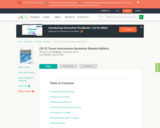
CK-12 Foundation's Geometry FlexBook is a clear presentation of the essentials of geometry for the high school student. Topics include: Proof, Congruent Triangles, Quadrilaterals, Similarity, Perimeter & Area, Volume, and Transformations.

Use different size triangle to determine how to solve for the area in this video lesson. Take quiz to check understanding. [3:41]

This video lesson demonstrates how to calculate the area of a triangle. It includes detailed examples including ones that use the Pythagorean Theorem. Students can check their understanding with an assessment. [10:43]
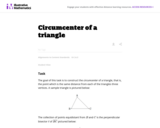
This task shows that the three perpendicular bisectors of the sides of a triangle all meet in a point, using the characterization of the perpendicular bisector of a line segment as the set of points equidistant from the two ends of the segment. The point so constructed is called the circumcenter of the triangle.